Antique Georgian chandeliers remain some of the most captivating lighting fixtures ever created, celebrated for their refined proportions, hand-cut crystals, and exquisitely detailed frameworks. Whether you’re a collector, a designer, or a homeowner drawn to historic interiors, these chandeliers offer a rare opportunity to bring true 18th-century artistry into a modern space.
Many authentic pieces such as early gas chandeliers adapted for electrification or multi-armed bronze designs still survive today with their original craftsmanship beautifully intact. They serve not only as decorative focal points but also as tangible connections to the Georgian era’s architectural elegance and social culture. With ten remarkable examples currently available across reputable marketplaces and auction houses, enthusiasts can explore an array of styles that showcase the period’s structural sophistication.
At NaturalLightLiving.com, we highlight the finest examples and provide guidance on sourcing verified pieces, understanding provenance, and recognizing authentic details that set genuine Georgian chandeliers apart from reproductions.
Video introduction Georgian chandeliers
Key Takeaways
- Authentic Georgian chandeliers feature 18th-century craftsmanship and historically accurate design.
- Auction houses, antique marketplaces, and trusted online platforms offer verified original pieces.
- Unique elements include hand-cut crystals, bronze frameworks, and rare early gas-to-electric conversions.
- Restoration specialists can update wiring while preserving period aesthetics.
- Market demand remains strong for chandeliers with documented provenance and artistic significance.
Elegant Two-Tier Georgian Chandelier From 1750
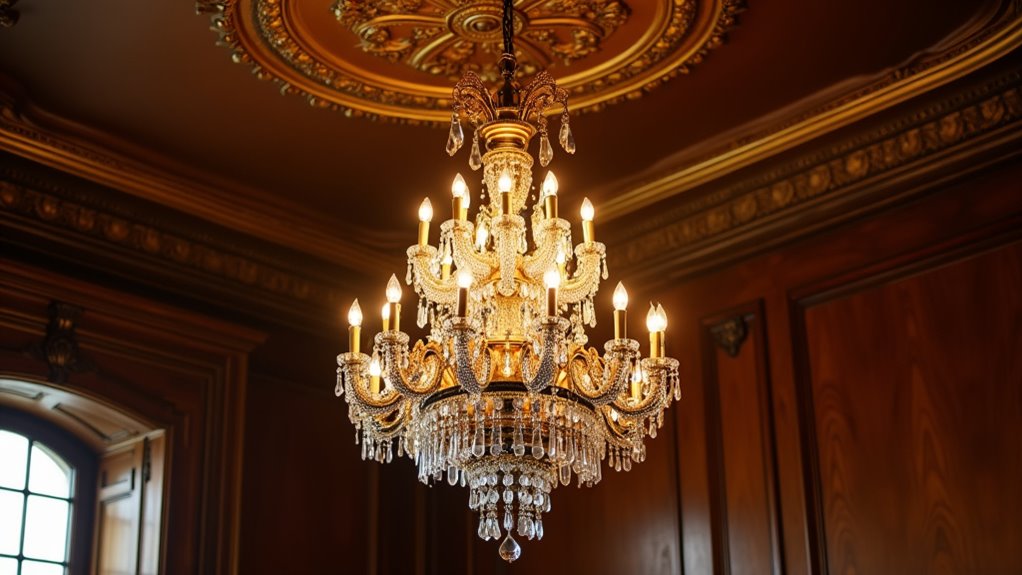
Though the allure of the Georgian period is often characterized by its refined aesthetic, the elegant two-tier Georgian chandeliers from circa 1750 exemplify this grandeur in the realm of lighting design.
These chandeliers feature a distinctive two-tier layout, where the upper tier is smaller in diameter than the lower, ensuring balanced proportions. Typically constructed from durable materials like bronze and brass, they often include meticulous hand-forged details that highlight artisanal craftsmanship.
Registration includes acceptance of the Terms & Conditions, ensuring that every purchase made is secure and compliant with regulations. These chandeliers are also reminiscent of the intricate detail found in the modern Collette Two Tier Chandelier.
Featuring a distinctive two-tier design, these chandeliers balance elegance with artisanal craftsmanship in durable bronze and brass.
Restoration techniques frequently involve retrofitting with electric wiring while preserving the original candle-holding structure. This innovative approach enhances functionality, providing even illumination across expansive spaces.
Their composition, often adorned with crystal prisms, not only amplifies light refraction but also adds to their historical significance and market value.
Antique Gilt Brass Chandelier With Crystal Accents
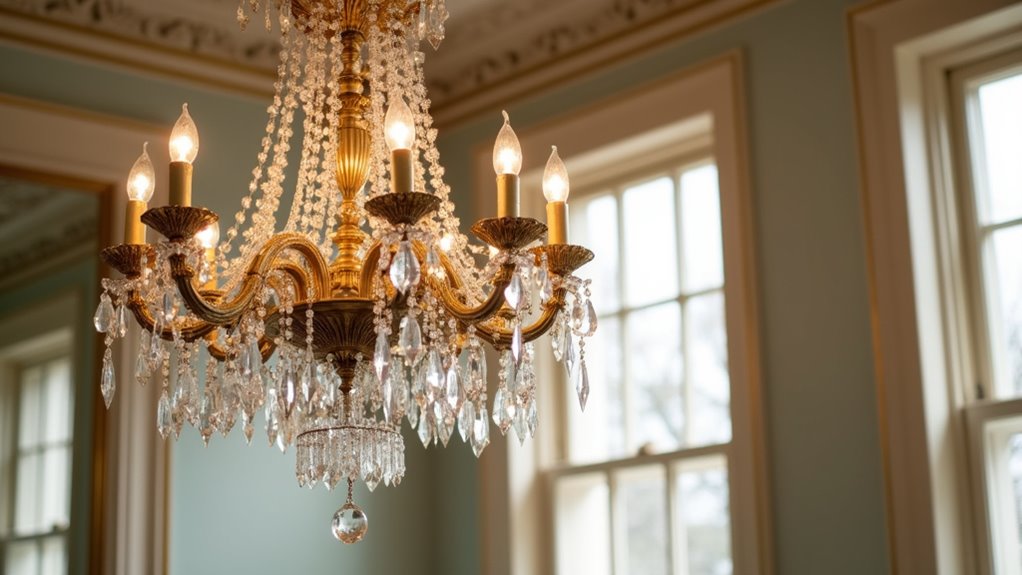
The antique gilt brass chandelier with crystal accents stands as a testament to the elegance of the 18th century, reflecting the opulence synonymous with the Georgian era. Its framework, meticulously crafted from gilt brass, features intricate designs and is adorned with lead crystal accents that enhance its luminosity.
| Component | Material | Function |
|---|---|---|
| Framework | Gilt Brass | Durable and ornate support |
| Crystal Drops | Lead Crystal | Light refraction and glamour |
| Ornamental Accents | Crystal | Visual enhancement |
| Design Style | Georgian | Classic aesthetic |
| Historical Source | Alpine | Natural beauty |
This chandelier represents a fusion of craftsmanship, utilizing antique chandelier restoration techniques to preserve its historical integrity and beauty, with crystal glass sources carefully chosen for their superior clarity.
Stunning Multi-Armed Georgian Chandelier From the 18TH Century
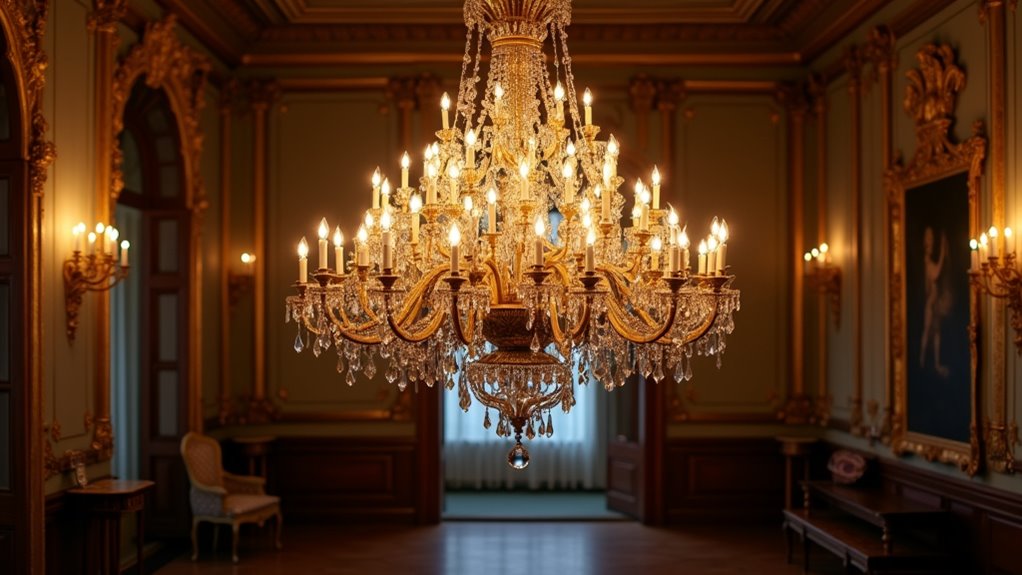
The stunning multi-armed Georgian chandelier from the 18th century exemplifies the era’s commitment to both aesthetic grandeur and social significance.
Such chandeliers not only illuminated elite spaces with their intricate designs and multiple candle holders but also served as a testament to the owner’s wealth and refined taste.
Their elegant visual features, including baroque curves and crystal accents, reflect a harmonious blend of functionality and decorative artistry that defines Georgian design.
Timeless Design Elegance
Admired for their sophisticated craftsmanship, the stunning multi-armed Georgian chandeliers from the 18th century exemplify the era’s pursuit of design elegance.
Characterized by symmetrical forms and multiple arms, these chandeliers combine timeless craftsmanship with exquisite materials like solid brass and lead crystal. The inclusion of cascading crystal prisms not only enhances visual appeal but also amplifies candlelight, reinforcing their role as chandelier symbolism of wealth and social status.
Decorative motifs such as acanthus leaves and detailed glasswork further establish the chandeliers as focal points in grand interiors. With multi-tiered designs reflecting classical restraint, these chandeliers mark a transition from functional lighting to luxurious decorative art, consolidating their enduring allure in the realm of antique elegance.
Historical Significance Explained
While the Georgian era was renowned for its artistic and architectural advancements, chandeliers emerged as significant cultural artifacts that reflected the societal shifts of the time.
Spanning from 1714 to 1830, the period’s opulence was manifest in the intricate designs of multi-armed chandeliers, which indicated wealth and social standing.
Candle making techniques evolved to produce lavish wax candles, illuminating the lavish evening social gatherings typical of this period.
Advances in glassmaking and craftsmanship resulted in brass and lead crystal constructions, including iconic elements such as ‘tent’ canopies and ‘waterfall’ chains.
As symbols of prestige, these chandeliers were primarily confined to grand residences, intertwining Georgian architecture and the refined tastes of the upper class, thereby reinforcing social stratifications.
Visual Features Showcase
A stunning multi-armed Georgian chandelier from the 18th century epitomizes the elegance and craftsmanship of its era, showcasing a harmonious blend of structural design and decorative artistry. Characterized by symmetrical brass arms and exquisite crystal craftsmanship, these chandeliers exemplify chandelier aesthetics profoundly. Each arm supports candle-like fittings and is adorned with intricate motifs, enhancing both form and function.
| Design Element | Description |
|---|---|
| Brass Arms | Multi-tiered, adorned with floral motifs |
| Crystal Components | Leaded glass, often with blue-grey tint |
| Light Functionality | Substantial illumination for grand spaces |
| Decorative Features | Gilded finishes, icicle drops, shadow play |
This visual opulence illustrates the elite status of their owners while amplifying the surrounding light with brilliance.
Hand-Cut Crystal and Bronze Chandelier From 1735
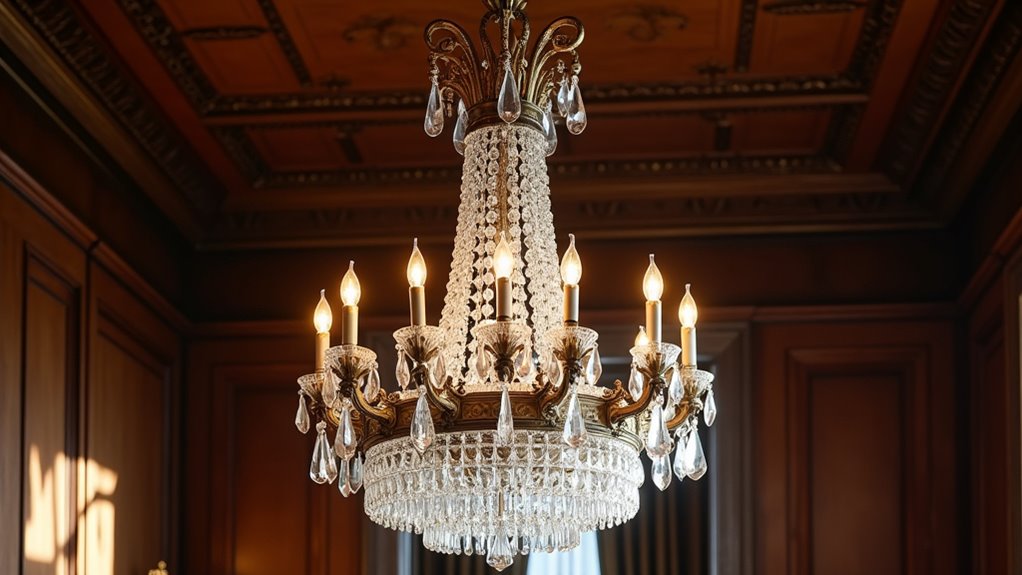
The hand-cut crystal and bronze chandelier from 1735 exemplifies the artistic and technical advancements of the early Georgian period, a time when elegance and symmetry defined lighting design.
Characterized by its eight-light configuration and intricate craftsmanship, this chandelier not only served a functional role but also enhanced the aesthetics of grand interiors.
Historical records, including those from Sotheby’s, underscore its provenance and significance within the context of Georgian decorative arts.
Historical Significance and Provenance
Hand-cut crystal and bronze chandeliers from the year 1735 serve as pivotal artifacts in understanding the evolution of Georgian lighting design, reflecting both technological advancements and the socio-economic landscape of the era.
Their historical significance includes:
- Symbolism of wealth, with wax candles representing status.
- Influence of cultural practices, as evenings transitioned into social events necessitating elaborate lighting.
- Technological development, transitioning from metal frameworks to robust glass arms.
- Provenanced connections, with notable makers like William Parker enhancing architectural aesthetics.
These chandeliers emerged during a time of heightened demand, epitomizing opulence and refinement in elite interiors.
Their contribution to both practical illumination and cultural expression underscores their enduring legacy in decorative arts.
Craftsmanship and Materials Used
While exploring the craftsmanship of Georgian chandeliers from 1735, one encounters a remarkable synthesis of artistry and engineering that underscored their status as prized decorative elements.
These chandeliers featured expertly hand-cut crystal beads and rosettes, meticulously shaped with diamond-tipped tools to enhance light refraction and brilliance.
The advent of advanced glass technology allowed for the creation of durable, intricately shaped glass arms, crucial for supporting the chandelier’s weight.
Bronze was commonly employed for the structural frame due to its strength and malleability, enabling intricate detailing including neoclassical motifs.
Artisan techniques such as casting and polishing were pivotal, ensuring not only aesthetic appeal but also material durability for these impressive luminous feats, ultimately balancing function with luxury.
Design Features and Aesthetics
Characterized by exquisite craftsmanship and refined aesthetics, the design features of Georgian chandeliers from 1735 reflect the era’s architectural ideals and decorative ambitions.
The design evolution of these chandeliers showcases several notable elements:
- A slender vase-shaped stem, diverging from earlier forms, suitable for grand assembly rooms.
- Multiple radiating arms that hold candles or oil lamps, adhering to classical symmetry.
- Hand-cut crystal ornamentation featuring blue-grey hues and natural motifs, emphasizing refined decorative techniques.
- Durable bronze frameworks with ormolu mounts that enhance visual depth, designed to showcase the brilliance of crystal elements.
Together, these aspects create a harmonious blend of function and beauty, epitomizing Georgian elegance and its lasting impact on interior design.
Exquisite Symmetrical Georgian Chandelier With Faux Candles
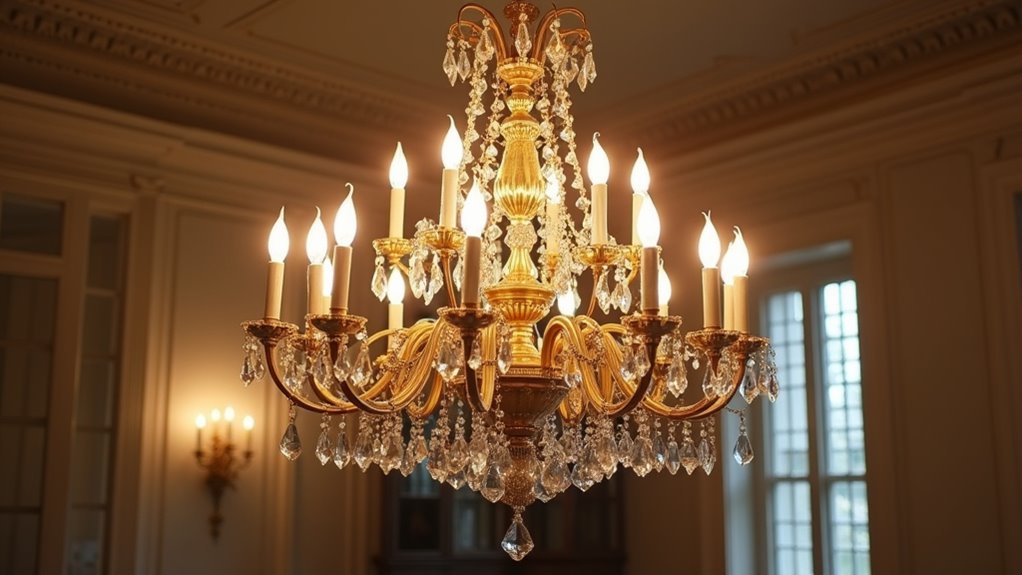
An exquisite symmetrical Georgian chandelier with faux candles exemplifies the elegance and craftsmanship of the 18th century.
Characterized by its balanced arrangement of curved arms and beautifully crafted candle cups, this chandelier reflects classical proportions derived from ancient architectural influences.
The faux candles, designed to emulate traditional wax, incorporate drip pans that enhance its authenticity while ensuring safety by eliminating fire hazards.
Made from high-quality brass and adorned with hand-cut crystals, this style amplifies light diffusion, creating a warm ambiance.
For optimal chandelier maintenance, regular dusting and avoiding moisture exposure are recommended.
Such fixtures remain a testament to the Georgian era’s aesthetic legacy, merging historical charm with contemporary safety features for modern interiors.
Vintage Thornham Hall Inspired Chandelier From 1742
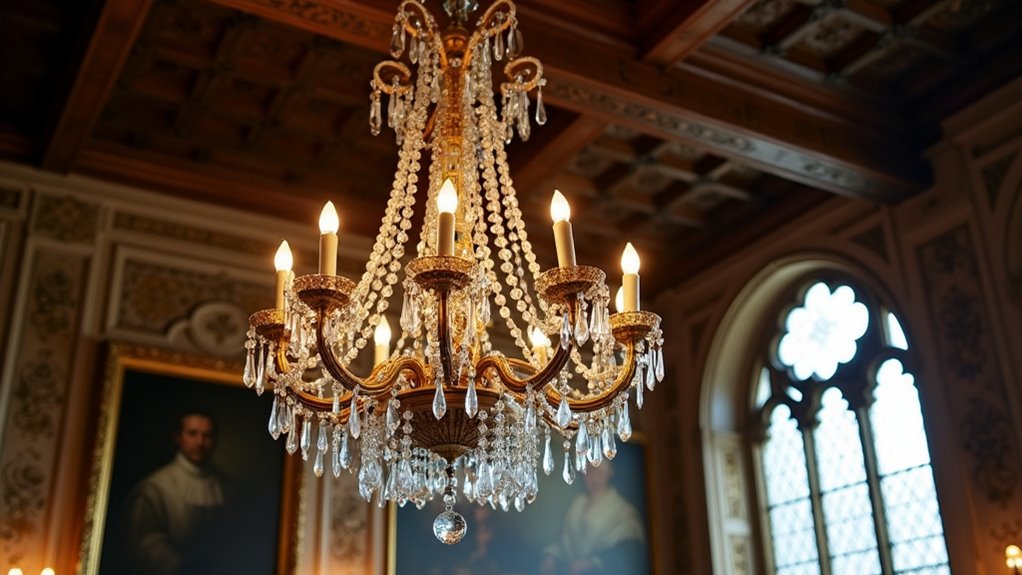
The Vintage Thornham Hall Inspired Chandelier, dating from 1742, serves as a significant representation of early Georgian craftsmanship, reflecting the historical grandeur of Thornham Hall.
Its multi-tiered design, characterized by dense crystal drops and ornate ormolu candle holders, exemplifies the period’s advancements in glass-making techniques and aesthetic elegance.
Today, original examples are exceptionally rare, with authentic pieces coveted by collectors while modern reproductions capture the essence of this iconic lighting fixture.
Historical Significance of Thornham
Although often overshadowed by more widely known designs, the Vintage Thornham Hall chandelier, crafted in 1742, stands as a significant artifact in the history of English decorative arts.
Its historical significance includes:
- Reflecting the Henniker legacy as part of Thornham Hall, a notable estate in Suffolk.
- Being one of the earliest English crystal chandeliers, marking a departure from imported French styles.
- Demonstrating advanced crystal craftsmanship through early lead glass techniques introduced in the 1720s.
- Inspiring later reproductions that underscore its influence on English chandelier development.
The chandelier not only highlights the decline of the Henniker family’s fortune but also commemorates their dedication to exquisite artistry and design, ensuring its enduring legacy within the decorative arts.
Design Features Overview
Crafted with meticulous attention to detail, the Vintage Thornham Hall chandelier from 1742 exemplifies early Georgian design principles through its combination of structural integrity and aesthetic simplicity. Its chandelier craftsmanship showcases the transition from ornate styles to a more restrained elegance, featuring solid candle arms and sophisticated metalwork features. The absence of excessive ornamentation highlights the practical yet graceful design ethos of the period.
| Feature | Description | Importance |
|---|---|---|
| Central Barrel | Hollow steel structure for support | Ensures durability |
| Candle Arms | 10 solid, plain arms without ornamentation | Represents early Georgian style |
| Crystal | Handcrafted full lead crystal elements | Enhances clarity and elegance |
Current Availability Insights
Exploring the current market for chandeliers inspired by the Vintage Thornham Hall from 1742 reveals a blend of historical significance and modern craftsmanship.
The collector market shows a robust interest, particularly due to reproduction trends that cater to various needs:
- Wilkinson Ltd specializes in 18th-century reproductions, offering both smaller and larger versions.
- The 1980s saw significant reproduction efforts by English Heritage for historical properties.
- Original chandeliers are extremely rare and typically held by museums.
- Bespoke reproductions are gaining traction, appealing to luxury residential and institutional settings.
These trends underscore the persistent demand for chandeliers that reflect Georgian heritage, ensuring that both original pieces and high-quality reproductions are highly valued in today’s market.
Rare Georgian Urn-Shaped Chandelier With Original Patina

The rare Georgian urn-shaped chandelier, distinguished by its original patina, represents a significant achievement in the evolution of lighting design during the 18th century.
Evolving from 17th-century Flemish metal designs, this chandelier features a slender urn-shaped central stem, a hallmark of Georgian style popularized by the esteemed glassmaker William Parker. Characteristic details such as elegant scroll arms and refined bobeches enhance its visual complexity while ensuring material authenticity.
Original components, including cut glass arms and distinct double-pointed pear pendants, contribute to its elegance. The chandelier’s authentic patina, resulting from decades of natural wear, adds historical context and value, separating genuine antiques from modern reproductions, while highlighting the craftsmanship of this iconic lighting design.
Multi-Tiered Georgian Chandelier With Beaded Edges
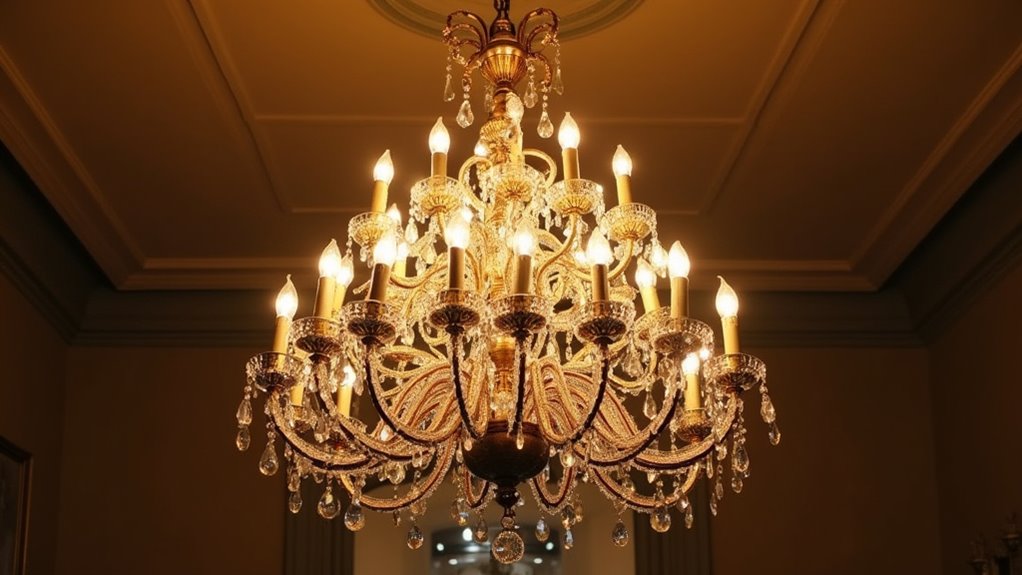
Multi-tiered Georgian chandeliers with beaded edges exemplify the height of 18th-century lighting design, merging architectural elegance with intricate craftsmanship.
These exquisite fixtures display:
- Tier arrangement featuring two or three levels for enhanced lighting coverage.
- Beaded detailing along the edges and drip pans, amplifying reflectivity and ornamentation.
- Complex arm designs such as the “double kink” arms, replacing earlier S-shaped scrolls, permit greater decorative flair.
- Delicate dressings of pear-shaped pendants and link pears, characteristic of Georgian style, add to the overall splendor.
Crafted from crystal glass or lead crystal, these chandeliers exemplify the artisanal skills of their time, marking a pivotal evolution in lighting functionality and aesthetic appeal during the Georgian period.
Classic Georgian Gas Chandelier Adapted for Modern Use
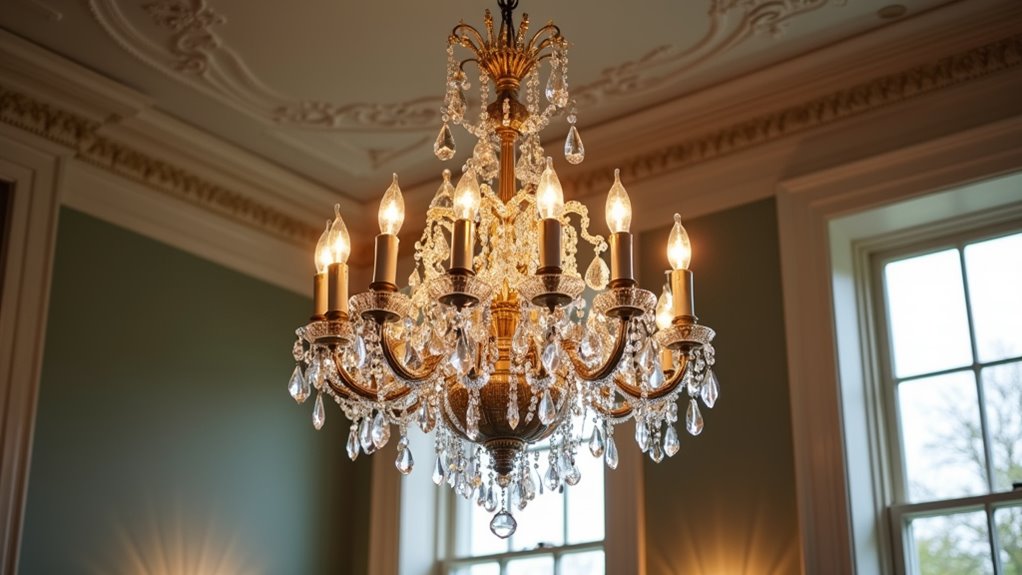
Adapting classic Georgian gas chandeliers for modern use involves a meticulous balance of historical integrity and contemporary functionality.
Originally illuminated by candles, these fixtures transitioned to gas lighting, featuring intricate burner designs such as Batswing and Fish Tail. The evolution of gas technology, particularly the introduction of downward-burning gas mantles post-1897, enhanced their utility, allowing for improved illumination.
Originally lit by candles, these chandeliers evolved through gas technology, enhancing illumination with intricate burner designs like Batswing and Fish Tail.
Historic adaptations frequently involve retrofitting these chandeliers with electric components, preserving their aesthetic while ensuring safety and compliance with modern standards. Careful rewiring retains original elements, such as elegantly curved arms and leaded crystal embellishments, creating both a functional and decorative piece.
Today, these chandeliers predominantly serve as atmospheric focal points, embodying the charm of Georgian design in contemporary interiors.
Original 18TH Century Chandelier With S-Shaped Scroll Arms
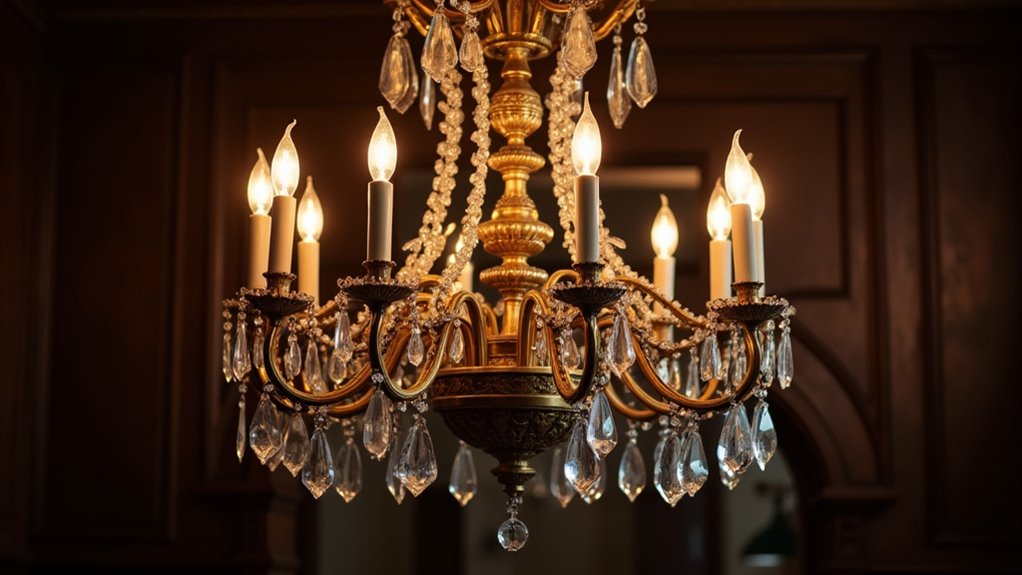
Original 18th-century chandeliers featuring S-shaped scroll arms exemplify the elegance and craftsmanship of the Georgian era, with many pieces meticulously designed to reflect the decorative arts of the time.
Key characteristics include:
- Craftsmanship: S-scroll variations often feature intricate applied leaf motifs and fluted nozzles, showcasing skilled artisanal work.
- Materials: Finely-cut crystal or brass arms, enhanced with molded candle cup designs (bobeches), contribute to the chandelier’s luster.
- Construction: The structural integrity is supported by large central stems, typically brass or gilt metal, resulting in balanced aesthetics.
- Historical Significance: Many chandeliers date from the 1730s to 1760s and originated from prestigious estates, influencing later designs.
Their enduring beauty and intricate detailing render these artifacts highly coveted in both museums and private collections.
Conclusion
Antique Georgian chandeliers offer more than stunning illumination they deliver a sense of heritage, artistry, and permanence that modern fixtures rarely match.
As interest in historic décor continues to rise, acquiring an authentic piece becomes both a design investment and a meaningful way to preserve 18th-century craftsmanship. Whether you’re seeking a dramatic multi-arm centerpiece or a rare converted gas chandelier, today’s market provides access to carefully restored, expertly authenticated examples that bridge the gap between past and present.
Take time to explore trusted sources, review provenance details, and evaluate craftsmanship so you can select a chandelier that will elevate your space for decades to come. For deeper guidance, curated recommendations, and insights into the most exceptional pieces available, visit NaturalLightLiving.com your resource for discovering and collecting timeless antique lighting. Now is the perfect moment to explore the stories behind these remarkable chandeliers and bring a piece of Georgian history into your home.


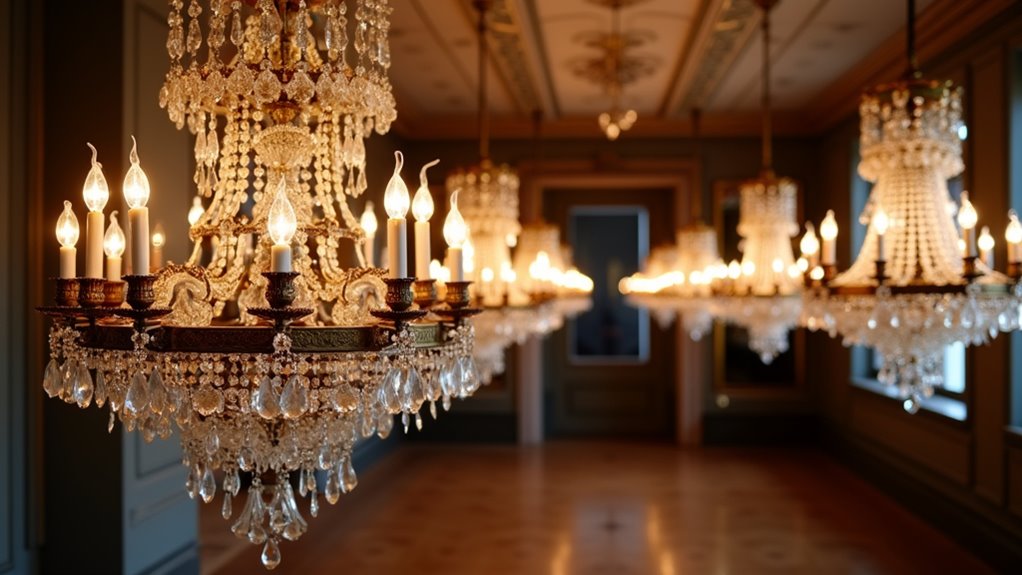
Bài viết cùng chủ đề:
Nickel Chandeliers: Elegant Lighting Ideas for Homes
Discover Stunning Elk Chandeliers for Sale
Transform your space with custom wrought iron chandeliers
Can you have two chandeliers in one room?
Italian Style Chandeliers for Sale Under $1200
Unique designs chandelier lighting for luxury homes